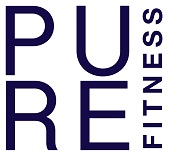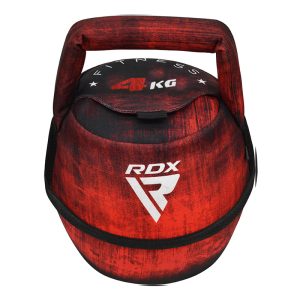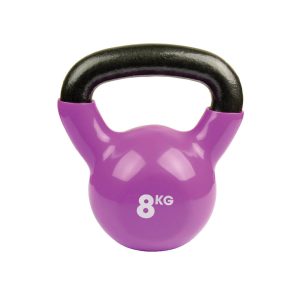Are you looking for a fun and effective way to enhance your workout routine? Look no further than the versatile kettlebell! In this article, you will discover simple yet powerful techniques to incorporate kettlebell exercises into your fitness regimen. Whether you’re a beginner or a seasoned enthusiast, these handy tips will help you maximize your strength, improve endurance, and achieve your fitness goals. Get ready to unleash your inner powerhouse with the dynamic world of kettlebell training!
Table of Contents
ToggleTypes of Kettlebell Exercises
Swings
The kettlebell swing is one of the most popular and effective exercises you can do with a kettlebell. It targets multiple muscle groups, including the glutes, hamstrings, and core. Start by standing with your feet shoulder-width apart and your knees slightly bent. Hold the kettlebell with both hands in front of your body, with your arms straight. Bend at your hips and swing the kettlebell back between your legs, then explosively drive your hips forward, swinging the kettlebell up to shoulder height. Repeat for the desired number of reps.
Turkish Get-up
The Turkish get-up is a challenging exercise that works your entire body, from head to toe. It improves core strength, shoulder stability, and overall mobility. Start by lying on your back with a kettlebell in one hand, arm extended straight above you. Bend your knee on the same side as the kettlebell and prop yourself up onto your elbow. From there, push through your heel and raise your hips off the ground, coming up into a kneeling position. Stand up while keeping the kettlebell extended overhead, then reverse the movement to return to the starting position.
Clean and Press
The clean and press is a compound exercise that targets multiple muscle groups, including the shoulders, back, and legs. It helps to build strength and power in the upper body while also working the lower body. Start by standing with your feet shoulder-width apart and the kettlebell in front of you on the floor. Hinge at your hips and grip the kettlebell with one hand. Drive through your legs and use the momentum to bring the kettlebell up to shoulder height, then press it overhead. Lower the kettlebell back down to the starting position and repeat on the other side.
Snatch
The snatch is a high-intensity exercise that targets the entire body and requires explosive power and coordination. It works your posterior chain, shoulder stabilizers, and core muscles. Start by standing with your feet shoulder-width apart and the kettlebell between your legs. Hinge at your hips and grasp the kettlebell with one hand, palm facing in. Explosively extend your hips, pulling the kettlebell up overhead in one smooth motion. As the kettlebell reaches the top, rotate your hand so that your palm faces forward. Lower the kettlebell back down between your legs and repeat on the other side.
Goblet Squat
The goblet squat is a fundamental exercise that targets the legs, glutes, and core. It helps to improve lower body strength and mobility. Start by holding the kettlebell with both hands in front of your chest, with your elbows tucked in. Stand with your feet shoulder-width apart. Push your hips back and lower down into a squat, keeping your chest up and knees tracking over your toes. Once your thighs are parallel to the ground, push through your heels to stand back up. Repeat for the desired number of reps.
Choosing the Right Kettlebell Weight
Assessing Your Strength Level
When choosing the right kettlebell weight, it’s important to assess your strength level. If you’re a beginner or have limited strength, it’s best to start with a lighter weight. This will allow you to focus on proper form and technique without putting too much strain on your muscles and joints. As you become more comfortable with the exercises, you can gradually increase the weight to continue challenging yourself.
Considering Your Fitness Goals
Your fitness goals should also play a role in determining the right kettlebell weight. If your goal is to build strength and muscle, you may want to choose a heavier weight that allows you to perform fewer reps with good form. If your goal is to improve muscular endurance or cardiovascular fitness, a lighter weight that allows you to perform more reps may be more suitable.
Starting with a Lighter Weight
Regardless of your strength level or fitness goals, it’s generally a good idea to start with a lighter weight and focus on mastering the movements. This will help you build a solid foundation of strength and technique, and reduce the risk of injury. As you become more comfortable and confident with the exercises, you can gradually increase the weight to continue challenging yourself and making progress.
Progressing to Heavier Weights
Once you have mastered the exercises with a lighter weight, you can gradually progress to heavier weights. This should be done incrementally to ensure that you continue to maintain proper form and technique. Aim to increase the weight by no more than 5-10% each time to avoid overexertion or injury. Keep in mind that progress is not always linear, and it’s important to listen to your body and adjust the weight as needed.
Proper Kettlebell Grip
Thumb Control
When gripping the kettlebell, it’s important to maintain thumb control. Place your thumb against the handle of the kettlebell, just above the handle’s cross section. This will help you maintain a secure grip and prevent the kettlebell from slipping or rotating in your hand during exercises.
Loose Grip
While maintaining thumb control, it’s important to avoid gripping the kettlebell too tightly. A loose grip allows for better wrist mobility and reduces the risk of developing hand and forearm fatigue. Think of your hand as a hook that is securely holding onto the handle without squeezing it excessively.
Avoid Over-Gripping
Additionally, it’s important to avoid over-gripping the kettlebell. Over-gripping can lead to unnecessary tension in your hand and forearm muscles, making it more difficult to perform the exercises with proper form and technique. Focus on using just enough grip strength to hold onto the kettlebell securely, without tensing up.
Maintain a Neutral Wrist Position
Lastly, it’s crucial to maintain a neutral wrist position throughout kettlebell exercises. Avoid excessive flexion or extension of the wrists, as this can increase the risk of injury. Keep your wrists in a straight line with your forearms, ensuring proper alignment and stability.
Warm-up and Safety Measures
Dynamic Warm-up Exercises
Before starting your kettlebell workout, it’s important to warm up your muscles and joints. Incorporating dynamic warm-up exercises can help increase blood flow, improve range of motion, and reduce the risk of injury. Examples of dynamic warm-up exercises include arm circles, walking lunges, high knees, and hip swings.
Stretching and Mobility Exercises
In addition to dynamic warm-up exercises, stretching and mobility exercises can also be beneficial. These exercises help to increase flexibility, lengthen muscles, and improve joint mobility. Some examples of stretching and mobility exercises that are particularly helpful for kettlebell training include hip flexor stretches, thoracic spine rotations, and hamstring stretches.
Protecting Your Back
One of the most important safety measures to keep in mind during kettlebell workouts is protecting your back. Since many kettlebell exercises involve hip hinge movements and lower body engagement, it’s important to engage your core and maintain a neutral spine throughout the exercises. This helps to prevent excessive stress on the lower back and reduces the risk of injury.
Using Proper Form and Technique
Using proper form and technique is crucial for both safety and effectiveness during kettlebell workouts. Focus on maintaining good posture, keeping the shoulders down and back, and using a controlled and fluid motion. It’s also important to breathe properly during exercises, inhaling on the eccentric phase and exhaling on the concentric phase.
Full-Body Kettlebell Workouts
Tabata Training
Tabata training is a high-intensity interval training (HIIT) method that involves performing exercises for 20 seconds at maximum effort, followed by 10 seconds of rest. This cycle is repeated for a total of 4 minutes per exercise. To create a full-body kettlebell Tabata workout, choose 4-6 kettlebell exercises and perform each exercise for 4 minutes, alternating between 20 seconds of work and 10 seconds of rest.
Circuit Training
Circuit training involves performing a series of exercises back-to-back with minimal rest in between. This helps to keep your heart rate elevated and provides a cardiovascular challenge while also targeting different muscle groups. To create a full-body kettlebell circuit workout, choose 5-8 kettlebell exercises and perform each exercise for a set amount of time or reps before moving on to the next exercise. Complete 2-3 rounds of the circuit with minimal rest in between.
Interval Training
Interval training involves alternating between periods of high-intensity exercise and periods of rest or lower-intensity exercise. This allows you to push your limits during the high-intensity periods and recover during the rest periods. To create a full-body kettlebell interval workout, choose 3-5 kettlebell exercises and perform each exercise for a set amount of time or reps, followed by a brief rest period. Repeat the circuit for a desired number of rounds.
Complexes
Kettlebell complexes are a series of exercises performed consecutively without resting between them. This helps to increase the overall intensity of the workout and challenge your strength, endurance, and coordination. To create a full-body kettlebell complex workout, choose 3-5 kettlebell exercises and perform each exercise for a set amount of reps or time. Complete the entire complex without resting, then rest for a short period before repeating the complex.
EMOM (Every Minute on the Minute) Workouts
EMOM workouts involve performing a set number of reps or a specific exercise within a minute, then resting for the remainder of the minute. This allows you to maintain a consistent pace and challenge your conditioning. To create a full-body kettlebell EMOM workout, choose 3-5 kettlebell exercises and perform a set number of reps for each exercise within a minute. Rest for the remaining time and repeat the cycle for a desired number of rounds.
Creating a Kettlebell Training Plan
Setting Goals
Before starting a kettlebell training plan, it’s important to set clear and achievable goals. This could be anything from improving strength and muscle tone, to increasing cardiovascular fitness or losing weight. Setting specific, measurable, attainable, relevant, and time-bound (SMART) goals can help guide your training and keep you motivated.
Determining Training Frequency
The frequency of your kettlebell training will depend on various factors, including your current fitness level, schedule, and goals. Aim for at least 2-3 kettlebell workouts per week to see noticeable improvements. Allow for at least one day of rest between training sessions to allow your muscles to recover and repair.
Selecting Exercises
When selecting exercises for your kettlebell training plan, it’s important to choose a variety of exercises that target different muscle groups and movement patterns. This will ensure that you are working your body in a balanced and comprehensive way. Consider incorporating exercises from each category mentioned earlier, such as swings, Turkish get-ups, cleans and presses, snatches, and goblet squats.
Balancing Strength and Cardio
To create a well-rounded kettlebell training plan, it’s important to balance exercises that target strength and muscle building with exercises that focus on cardiovascular endurance. This can be achieved by incorporating both high-intensity exercises and lower-intensity exercises into your workouts. For example, you might include exercises like swings and snatches for cardio, and goblet squats and Turkish get-ups for strength.
Tracking Progress
Tracking your progress is an important part of any training plan. Keep a record of the exercises, weights, sets, and reps you perform during each workout. This will allow you to monitor your progress over time and make adjustments as needed. You can also track other metrics, such as resting heart rate, body measurements, and weight, to get a holistic view of your progress.
Incorporating Kettlebell into Cardio Workouts
Kettlebell Cardio Intervals
Incorporating kettlebell cardio intervals into your workouts is a great way to boost your heart rate and burn calories. Choose a cardio exercise, such as jogging or jump rope, and perform it for a set amount of time. After each cardio interval, perform a kettlebell exercise, such as swings or snatches, for a set amount of reps. Alternate between the cardio and kettlebell exercises for the desired duration of your workout.
HIIT (High-Intensity Interval Training)
HIIT workouts are a popular and effective way to maximize calorie burn and improve cardiovascular fitness. Combine kettlebell exercises with bodyweight exercises or other cardio exercises to create a challenging HIIT workout. Perform each exercise for a set amount of time, followed by a short rest period. Repeat the circuit for a desired number of rounds.
Kettlebell Swings for Cardio
Kettlebell swings are a highly effective exercise for cardiovascular conditioning. Start by performing a set number of swings, aiming for a quick and powerful hip hinge movement. Rest for a short period, then repeat for the desired duration of your cardio workout. Adjust the weight and number of swings based on your fitness level and goals.
Combining Kettlebell and Running/Cycling
To incorporate kettlebell training into your running or cycling routine, you can perform kettlebell exercises as part of your warm-up or cool-down. For example, you could start with a few minutes of jogging or cycling to warm up, then perform a set of kettlebell swings or goblet squats. After your main running or cycling workout, use the kettlebell for a few exercises to target specific muscle groups or finish off your training session.
Benefits of Kettlebell Training
Improves Strength and Power
Kettlebell training is a highly effective way to improve both strength and power. The dynamic movements and full-body engagement required in kettlebell exercises help to build overall strength and increase power production. This can translate to improved athletic performance and everyday functional movements.
Enhances Cardiovascular Fitness
In addition to strength and power, kettlebell training also provides a great cardiovascular workout. The combination of high-intensity exercises and minimal rest periods helps to elevate the heart rate and improve cardiovascular endurance. Regular kettlebell training can lead to increased stamina and improved overall cardiovascular fitness.
Burns Calories and Promotes Weight Loss
Kettlebell workouts are known for their calorie-burning potential. The combination of strength training and cardiovascular conditioning in kettlebell exercises creates a high-energy expenditure, leading to increased calorie burn. When combined with a balanced diet, regular kettlebell training can contribute to weight loss and body composition changes.
Increases Core Stability
Many kettlebell exercises require a strong and stable core. The off-centered weight distribution of the kettlebell challenges the core muscles and forces them to work harder to maintain stability and control. Regular kettlebell training can help to strengthen the deep core muscles, improve posture, and enhance overall stability.
Builds Muscular Endurance
Kettlebell exercises involve repetitive movements and sustained effort, which help to build muscular endurance. The combination of strength and cardiovascular conditioning in kettlebell workouts helps the muscles become more resistant to fatigue, allowing you to perform physical tasks for longer periods without experiencing muscle fatigue.
Improves Grip Strength
Gripping and controlling the kettlebell challenges the muscles in your hands, forearms, and wrists. Over time, regular kettlebell training can lead to improved grip strength, which can have carryover benefits in various activities and sports. Improved grip strength can also contribute to better overall strength and stability in exercises and daily tasks.
Common Mistakes to Avoid
Using Incorrect Form
One of the most common mistakes in kettlebell training is using incorrect form. This can increase the risk of injury and reduce the effectiveness of the exercises. It’s important to prioritize proper technique and form over the amount of weight or number of reps. Focus on using a controlled and fluid motion, maintaining good posture, and engaging the appropriate muscles throughout each exercise.
Lifting Too Heavy Too Soon
Another common mistake is attempting to lift too heavy of a weight before mastering the proper technique and form. This can lead to improper movement patterns, increased risk of injury, and limited progress. It’s important to start with a lighter weight and gradually increase the load as you become more comfortable and confident in your abilities.
Neglecting Warm-up and Cool-down
Skipping the warm-up and cool-down is a common mistake that can increase the risk of injury and hinder your overall progress. Warm-up exercises prepare your muscles and joints for the workout by increasing blood flow and raising your body temperature. Cool-down exercises help to gradually lower your heart rate and prevent muscle soreness. Make sure to include both a warm-up and cool-down in each kettlebell training session.
Not Progressing with Proper Technique
When progressing to heavier weights, it’s important to continue focusing on proper technique and form. It’s easy to sacrifice form in order to lift more weight, but this can increase the risk of injury and compromise the effectiveness of the exercises. Take the time to master the technique at a lighter weight before progressing to heavier loads.
Ignoring Recovery and Rest Days
Pushing yourself too hard without allowing for proper recovery and rest can impede your progress and increase the risk of overuse injuries. Rest days are essential for allowing your muscles and joints to repair and adapt to the demands of the training. Make sure to listen to your body and incorporate rest days into your kettlebell training plan.
Tips for Effective Kettlebell Training
Focus on Proper Technique
Proper technique is key to effective and safe kettlebell training. Take the time to learn and master each exercise’s proper form before increasing the weight or intensity. Focus on engaging the correct muscles, using a controlled motion, and maintaining good posture throughout each exercise.
Control Breathing
Breathing is an often overlooked aspect of kettlebell training, but it plays a crucial role in maintaining proper form and controlling your movements. Inhale during the eccentric phase (lowering the kettlebell) and exhale during the concentric phase (lifting the kettlebell). This breathing pattern helps to stabilize your core and support your movements.
Engage Core Muscles
Engaging your core muscles throughout kettlebell exercises is essential for stability and proper movement. Focus on drawing your belly button in towards your spine, activating your deep core muscles, and maintaining a neutral spine position. This will help to protect your back and improve the effectiveness of the exercises.
Listen to Your Body
It’s important to listen to your body and adjust your training accordingly. Pay attention to any discomfort or pain during exercises, and modify or stop if necessary. Remember that progress is not always linear, and it’s important to prioritize your overall well-being and safety.
Incorporate Variety
Incorporating variety into your kettlebell workouts can help to keep you motivated and prevent boredom. Try different exercises, workout formats, and training styles to challenge your muscles and keep your workouts interesting. This can also help to target different muscle groups and promote a well-rounded training program.
Seek Professional Instruction
If you’re new to kettlebell training or unsure about proper form and technique, consider seeking professional instruction. Working with a certified kettlebell trainer or attending kettlebell classes can help you learn the basics, receive feedback on your technique, and progress safely. They can also help you design a training plan tailored to your specific goals and fitness level.









